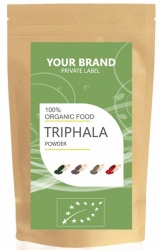Info
TRIPHALA is a traditional herbal formulation made from the dried powder of three different fruits. The name comes from combining the Sanskrit words “tri” meaning three, “phala” meaning fruit and “churcha,” which means powder.
Triphala contains gallic acid, ellagic acid and chebulinic acid, which are all strong antioxidants. It also has flavonoids and polyphenols, which have antibacterial, anti-inflammatory and tidiarrheal abilities.
Triphala’s purported uses include the natural treatment of cancer, infections, gastrointestinal issues, inflammation, high cholesterol, immune system malfunction and even cancer.
Triphala is derived from the following three fruits: amla, haritaki and bibhitaki.
Amla (Emblica officinalis) is also commonly known as Indian gooseberry and has been one of Ayurveda’s most prized rejuvenators for centuries. The fruit is very high in vitamin C and is used either alone or in combination with other plants to treat the common cold and fever and as a diuretic, digestive, laxative, liver tonic, restorative and anti-inflammatory agent. While useful for all doshas, it’s said to be particularly effective for balancing the Pitta dosha.
Haritaki or Harada (Terminalia chebula) is also called the Tibetan “king of medicine.” Haritaki is widely used in the traditional medicine of India and Iran to treat a variety of health issues including constipation, dementia and diabetes. It’s also anti-inflammatory and calming to the Vata dosha.
Bibhitaki (Terminalia bellirica) is another powerful ancient rejuvenator with detoxifying qualities. It is extensively used in traditional Indian Ayurvedic medicine for the treatment of diabetes, high blood pressure and rheumatism. Studies have even shown that this fruit’s extract might be able to inhibit atherosclerosis plaque progression.This fruit is known known for benefits to the dosha known as Kapha.
Triphala contains gallic acid, ellagic acid and chebulinic acid, which are all strong antioxidants. It also has flavonoids and polyphenols, which have antibacterial, anti-inflammatory and tidiarrheal abilities.
Triphala’s purported uses include the natural treatment of cancer, infections, gastrointestinal issues, inflammation, high cholesterol, immune system malfunction and even cancer.
Triphala is derived from the following three fruits: amla, haritaki and bibhitaki.
Amla (Emblica officinalis) is also commonly known as Indian gooseberry and has been one of Ayurveda’s most prized rejuvenators for centuries. The fruit is very high in vitamin C and is used either alone or in combination with other plants to treat the common cold and fever and as a diuretic, digestive, laxative, liver tonic, restorative and anti-inflammatory agent. While useful for all doshas, it’s said to be particularly effective for balancing the Pitta dosha.
Haritaki or Harada (Terminalia chebula) is also called the Tibetan “king of medicine.” Haritaki is widely used in the traditional medicine of India and Iran to treat a variety of health issues including constipation, dementia and diabetes. It’s also anti-inflammatory and calming to the Vata dosha.
Bibhitaki (Terminalia bellirica) is another powerful ancient rejuvenator with detoxifying qualities. It is extensively used in traditional Indian Ayurvedic medicine for the treatment of diabetes, high blood pressure and rheumatism. Studies have even shown that this fruit’s extract might be able to inhibit atherosclerosis plaque progression.This fruit is known known for benefits to the dosha known as Kapha.



 NO PARABENS AND PH NEUTRAL
NO PARABENS AND PH NEUTRAL Vegan product,
Vegan product, SELECTED NATURAL
SELECTED NATURAL MODERN production
MODERN production